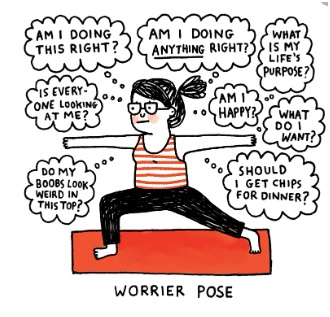A Coaching Power Tool Created by Susanne Buetikofer
(Transformational Coach and Career Coach, SWITZERLAND)
 Definition:
Definition:
Worrier: (noun)A person who worries a great deal, especially unnecessarily, and thinks about unfortunate things that might happen.
Warrior: (noun) Although logically linked with someone engaged in war, a warrior can be anyone who fights the good fight, whether in politics, on the job, or just as a “weekend warrior” trying to accomplish multiple tasks during off-hours at home
This Cartoon by Gemma Correll sums it up well for me…I am a worrier – always have been and most probably will always deal in a way with this issue.
As Vocabulary.com dictionary says, someone who worries a lot – thinks about unfortunate things which might happen. That is me, always thinking the worst will happen to my family or myself; the plane gets canceled, the beach holidays will most definitely be rainy and wet or I definitely won’t get the promotion or the job.
When embarking on my journey to become a coach, I realized that I needed to tackle these negative feelings. I couldn’t just try helping to improve the lives of my clients, but also find a way I can unleash the warrior in me on my own. A challenge I started addressing with my numerous peer coaches. I wanted to turn these feelings around into being in a state of a warrior fighting for success, being positive about the good weather during the beach holidays, and for a promotion!
There is scientific reasoning for worriers or warriors (Peele, 2013). It is described that we all get a certain gene from our father and another one from our mother. It can be one of both – one of the warriors and one of the worriers, which is the case for about half of all people. With this mix of enzymes, they find themselves being a blend of worriers and warriors. There is a quarter of the population who carries a warrior or worrier only genes. These types can bring up extreme reactions to stress, in the case of Peele’s study, in schoolchildren for instance.
Application in Coaching
Worrier clients are quite common and they declare very early on that they worry too much and that they want to fight this constant feeling of worrying in the back of their head. By challenging their way of thinking; “what if you weren’t looked over for the promotion – how would that look like, or what if you were able to lose the 5 kilos – how that make you feel?” clients get an awareness that there might be a possibility to overcome this worry. Furthermore, if the coach can help the clients to compare both states of mind and hopefully come to the conclusion that being a Warrior is more successful and fulfilling than having troubling thoughts and being full of worries, then coaching can create that shift of perspective.
A powerful tool to accompany the clients on this journey can be a visualization exercise – it shows the clients how life after the promotion could look like or how they would look once they have shed the kilos they wanted. By imagining the new self it suddenly looks that a positive thing might happen. From there on, the coach can help the client how to get there.
Following questions can be asked to help transform the worriers into warriors:
- What is healthy about you worrying vs. being a warrior?
- How are these worries helping you going forward?
- What could a different approach to the issue be that creates positive feelings?
- What can you learn from this situation?
- What can you do to transform your worry into a fight for ..?
- What are some action steps you can take to solidify this shift in beliefs?
Reflections clients can use to address their worries:
- What are my gains in becoming a warrior?
- How much is it worth remaining in the worrier state?
- What if it were worth becoming a warrior instead of staying a worrier?
For me, the “what if” questions are very helpful – they help me open up a new way of looking at things and realizing how stuck I sometimes am worrying. When this question is asked by my coach, I start reflecting and suddenly a new awareness comes up and the worrying issue becomes clearer, more positive, and disappears miraculously. There, the quote of Tolle makes sense and as soon as the worriers understand it, they can start leaving behind their negative feelings.
Worry pretends to be necessary.—Eckhart Tolle
The challenge of worriers is to get certain sustainability when it comes to overcoming their worries. Soon, a new issue comes up, and very quickly one starts being anxious again. It is therefore crucial not to avoid the worries and pretend they are not there. Instead, they should be acknowledged and accepted as a regular thought, emotion, or feeling which can be changed – and turned into a state of mind of a warrior. When practicing this way of letting the worries surface and addressing them, these feelings can be transformed into positive ones and the warrior state of mind can be brought upon. A state of mind that helps to live life fuller than before.
As a consequence, the cartoon figure of Gemma Correll will be able to turn the worrier pose into a warrior one and let her mind be filled with positive thoughts.
References:
Peele, S., 2013, What genes tell us about worrying, Psychology Today [online][Accessed 3rd June 2020]
Sreechinth, C., 2016, Wisdom of Eckhart tol
